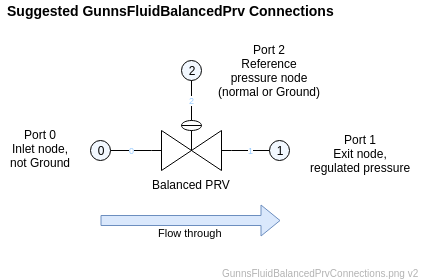GunnsFluidBalancedPrv - nasa/gunns GitHub Wiki

This link models an ideal balanced pressure reducing valve (downstream pressure regulator valve), which reduces the pressure of the valve's through-flow to control the downstream pressure to a desired pressure setpoint. This is a simpler alternative to using the GunnsFluidRegulatorValve link in some situations. This is a 3-port link:
- Port 0 - valve flow inlet, similar to a GunnsFluidValve.
- Port 1 - valve flow exit, similar to a GunnsFluidValve. Fluid flows through the valve between Ports 0 and 1, just like a normal GunnsFluidValve.
- Port 2 - reference pressure port. The valve controls the downstream pressure setpoint relative to this node's pressure. Connecting this port to the Ground node causes the valve to control absolute pressure. Connecting this to an ambient node causes the valve to control gauge pressure relative to the ambient pressure.
This link has several important advantages & disadvantages relative to GunnsFluidRegulatorValve, and these should be considered when deciding which type of link to use. The advantages of this link are:
- It is simpler to tune.
- It gives more stable output pressure & flow rate and avoids most chatter & overshoot.
- It doesn't need stability volumes on the inlet & exit nodes.
This link's simplifications and disadvantages are:
- It doesn't have a leak-thru malfunction. This can be worked around by placing a separate GunnsFluidLeak link in parallel.
- It doesn't have any stuck-to-position malfunctions.
- It can't model convective heat transfer with the wall.
- It can't model expansion cooling of gas flow-thru.
- There is no difference between crack & reseat pressure. Rather, this valve simply has a single pressure setpoint.
- It is only good for single-constituent mixtures because it doesn't conserve constituent masses when inlet mixture is changing. Mixtures are still allowed if you can accept this error.
- Similar to mixture, it doesn't conserve energy when inlet temperature is changing (errors are small).
- It can only control the immediate downstream node, whereas GunnsFluidRegulator can also control the upstream node or any other nearby node.
- It does not allow backflow.
Other important differences are:
- This link models a linear drop in outlet pressure under load, whereas GunnsFluidRegularValve models the drop across the valve as the square of flow rate, like most conductors.
- It models "balanced" input -- output pressure & flow rate isn't affected by changing inlet pressure. Outlet pressure is only affected by flow rate.
This has similar connections as GunnsFluidRegulatorValve except there is only one reference pressure port instead of two. The suggested connections are shown below:

Port Connection Rules (These are limitations on the port connection to nodes that the link enforces in run-time):
- Port 0 cannot connect to the Ground node.
- Ports 1 and 2 cannot connect to the same non-Ground node.
Other Rules (These are extra rules you should always try to follow):
- Same as GunnsFluidConductor.
Configuration Data Parameters:
- exitPressureDroop (default = 0 (kPa*s/kg), must >= 0): This controls how much the outlet pressure drops below the regulated pressure setpoint per unit of mass flow. A value of zero acts like an ideal pressure source where there is no pressure drop. Larger values cause more pressure drop per unit mass flow. The outlet pressure drop (or "droop") is directly proportional to the flow rate by this term.
Input Data Parameters:
- malfBlockageFlag: Same as GunnsFluidValve.
- malfBlockageValue: Same as GunnsFluidValve.
- malfPressureBiasFlag (default = false): Initial state of the control pressure bias malfunction flag.
- malfPressureBiasValue (default = 0.0 (kPa)): Initial bias value of the control pressure bias malfunction. This value adds to the valve's pressureSetpoint, so a positive malfunction value causes the valve to control a higher pressure.
- pressureSetpoint (default = 0.0 (kPa), must >= 0): This is the normal control setpoint that the regulator controls the exit pressure to.
- N/A
- N/A